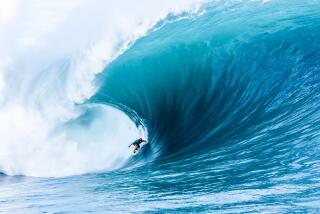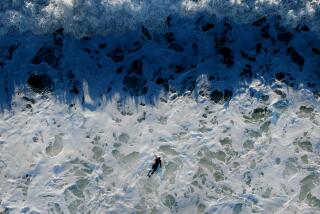Stephanie Elliott Is Happy She’s Not One of the Boys in Catamaran Race
An all-woman crew is among the 18 entries scheduled to start the first 11-day Pacific 1000 catamaran sailing race at Long Beach today and, frankly, the crew is concerned.
The women aren’t sure the men know what they’re getting into.
“I think they’re very good sailors,” said Stephanie Elliott, assessing her male rivals, “but I don’t think they’ve done a lot of night sailing. I don’t think they understand how mighty the ocean is.”
Pacific 1000 entries are limited to 20 feet in length and an 8 1/2-foot beam--the basic, catamaran designed for lakes or protected inshore waters, not for places this event proposes to go. Sailed in 10 daily segments, with the next-to-last day off, the course zigzags about 1,000 miles from Santa Barbara to San Diego and around Catalina and the Channel Islands, ending at Huntington Beach Aug. 3.
Elliott’s husband, Skip, a Newport Beach sail maker, wasn’t completely sold on his wife’s idea at first.
“But I think he’s changed his mind from ‘Anybody that goes offshore in a catamaran is a fool,’ ” she said. “I’ve done so much ocean racing in the last three years that I know what’s important in safety gear. I know what to wear and what to have and what to do.”
Skip Elliott returned from the Goodwill Games in the Soviet Union this week with a silver medal in the Tornado catamaran class. Who is he to say his wife can’t sail around Catalina with her friends if she wants to? Besides, he can blame only himself for stirring her old competitive fires back to life.
Stephanie, 41, grew up sailing dinghies against Dennis Conner in San Diego Bay but abandoned the sport when she was 13 because of the competitive pressure. Later, she started raising two sons, and while Skip ran Olympic campaigns she managed the sail loft and the family real estate and investment operations. There wasn’t much time for sailing.
“I kept everything here real stable so he could go out and sail and concentrate,” she said. “Three years ago I started sailing again. When I came back into sailing I swore that I would never skipper again. I didn’t like the pressure of always being the one to make decisions. I enjoyed perfecting the crew technique.
“I’ve studied and trained and sailed to do foredeck. I’ve done two Cabo races, Puerto Vallarta, Transpac. Then this March I went to Bermuda with Skip for the Tornado worlds (championships). That’s the first time we’d skippered and crewed together in a long time.
“When I came back I started skippering again and picked different people to sail against. In two months’ time I picked up a lot of my old techniques. I’m all of a sudden becoming very competitive.
“This race has thrown my whole organization off schedule. The kids are saying, ‘We don’t have anything to eat, Mom, we don’t have any clothes.’ I’ve been working out very hard. I run every day.”
The minimum combined crew weight for the event is 325 pounds. That’s two average-size male sailors--or three women. Elliott’s crew members are Theresa Funaro, 24, a triathlete and 105-pound apprentice policewoman from Seal Beach, and Diana Riggs, 35, a professional ballet dancer from Long Beach. Together they weigh 340 pounds.
Even if they didn’t need three women to make the weight, Elliott thinks it’s a good idea.
“We could do it for a race, but I don’t think 11 days would be particularly smart. This boat has a lot of horsepower. Handling the main is very difficult for a woman. Women are not strong in the shoulders like men.
“So we picked up an extra set of hands. If there’s enough wind, Diana is the first one that goes out on the wire (trapeze), and then she has the leverage. Theresa does the jib and they both do the spinnaker. At first it was too many bodies, but now we have it coordinated quite good.
“Everyone had an idea that when you’re a woman there are certain things you can do well and certain things you can’t, and you have to accept that and make the best of it. We can’t pull a halyard (straight) down the mast, but we can pull it this way (laterally, through a block). That’s one of the things I learned on the big boats.
“We’ve been over and we can right the boat, but it does take three of us.”
Elliott is not a feminist sailor.
“Not at all, but we have a sponsor (Custom Nails of Modesto) that does nails, and we got the sponsorship because she wanted girls to sail the boat.”
And sail it they will, without naive notions.
“I’ve done 8,000 miles of actual racing,” Elliott said. “I’ve done the helm in the dark. The difference on a big boat is that you get relieved on watch. Going to Bermuda was a good thing for us. It opened our eyes to what could happen.”
Her worst fear?
“Ships at night. If the winds get light, we’ll be out there. We have running lights and a radar reflector, but there are so many ships and we’re so small. That and hitting something in the water. Capsizing we can handle. We have VHF radio. We have chase boats, spotting planes, the Coast Guard, and we aren’t far off shore, so if something did happen they could find us.”
These catamarans, some deliberately overpowered for speed, are capable of 30 knots, although they probably will average closer to 20 in normal conditions. Still, that makes Friday’s Catalina-to-Long Beach spinnaker reach about a 2 1/2-hour ride.
“It’s such a smooth sensation that you don’t have that terror in you that any minute you’re gonna stuff the bows and go catapulting through the air,” Elliott said. “You don’t realize you’re going so fast.
“We have to think for ourselves,” Elliott said. “There’s no one there to bail us out. I don’t think anything is gonna frighten us.”
Pacific 1000 Notes
The start at the Claremont Street ramp in east Long Beach will be sailing’s version of Le Mans. At a countdown signal, the sailors will shove their boats off the beach at noon and head for Avalon. . . . Randy Smyth, the Huntington Beach sail maker, is the favorite, although he won’t have regular crew Jay Glaser. They won an Olympic silver medal in 1984, but Glaser crewed for Stephanie Elliott’s husband, Skip, in the Goodwill Games in the Soviet Union this month. Instead, Smyth will have Jim Hill, a former sailing buddy from San Francisco. Smyth has been experimenting with a radical V-shaped winged mast. One broke on the beach under stress recently.
More to Read
Go beyond the scoreboard
Get the latest on L.A.'s teams in the daily Sports Report newsletter.
You may occasionally receive promotional content from the Los Angeles Times.










